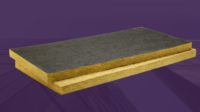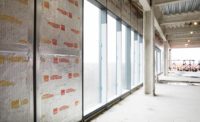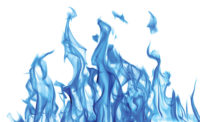Assessing Leap-Frog Risk: A New Testing Method








What do the terms “auto-exposure” and “leap-frog” mean in reference to high-rise buildings? Both describe the upward spread of fire from one floor of a building to the floor above. Regardless of how this risk is described, the 2017 Grenfell Tower serves as a tragic example of external vertical fire spread in high rise buildings.
Occurring in the United Kingdom, the Grenfell fire claimed more than 70 lives. Flames climbed 20 stories in just 35 minutes. In the fire’s aftermath, building owners, life safety experts and designers/architects have carefully examined the factors that may have accelerated the fire’s vertical spread. As post-fire analysis points to possible concerns with the building code, new testing standards are being proposed to address the threat of vertical fire spread on a building’s exterior.
Two threats of concern when it comes to vertical fire spread are the “leap-frog” effect and the increased use of combustible cladding materials. “Leap-frog” occurs when fire on a lower floor breaks through the vision glass of windows and reenters through a window above. This condition allows the fire to ignite combustible materials, breaking out more windows and perpetuating the fire’s climb up the building.
To address this risk, a new testing method—ASTM E2874-19 assesses risk of fire spread vertically from floor to floor. The new testing standard should be considered in future updates of the International Building Code as it provides useful assessment for professionals designing and specifying exterior wall components and systems.
Addressing Gaps in the Building Code: Spandrel Walls and Vertical Separation of Openings
Design factors can contribute to vertical fire spread when a building’s curtain wall construction design does not specify adequate spandrel height protection. The term spandrel refers to the space between the top of the window on one floor and the sill of the window in the story above. Typically constructed from materials that offer enhanced fire resistance, larger spandrel areas can help resist the external spread of fire.
Although protection of the linear opening between a non-rated exterior curtain wall and a rated floor slab is a requirement in the IBC building code, the protection against vertical fire spread via leap-frog flame propagation is not currently addressed. There are references for protecting the exterior curtain wall, however, the building code can complicate the challenge of addressing vertical fire risk.

For example, Section 715.5 (Spandrel Wall) of the International Building Code specifies that the height and fire-resistance requirements for curtain wall spandrels shall comply with Section 705.8.5. Addressing the vertical separation of openings, Section 705.85 requires openings in exterior walls in adjacent stories to be separated vertically to protect against exterior fire spread on buildings where the openings are within 5 feet (1,524 millimeters) of each other horizontally. Section 705.8.5 further specifies the opening in the lower story is not a protected opening with a fire protection rating of not less than .75 hour. This section further states that the openings shall be separated by a minimum 3 feet of rated spandrel. However, with the installation of an automatic sprinkler system, section 705.8.5 can be ignored. Section 715.4 (Exterior Curtain Wall/Floor Intersection) requires that the void created where the non-rated exterior curtain wall and rated floor or floor/ceiling assemblies intersect be sealed with an approved material or system, tested to ASTM E 2307 (Standard Test Method for Determining Fire Resistance of Perimeter Fire Barriers Using Intermediate-Scale, Multi-story Test Apparatus) to prevent the interior spread of fire. Such systems tested to ASTM E2307 must provide an F rating for a time period equal to the fire resistance of the floor assembly. However, the IBC does not really address the spread of fire from the leap-frog effect.
A New Testing Method to Measure Leap-frog Risk
A gap in the codes to address leap-frog risk is a huge concern; particularly in buildings where occupants may be unable to evacuate on their own. To support architects in assessing leap-frog risk, a new testing method—ASTM E2874-19: Standard Test Method for Determining the Fire-Test Response Characteristics of a Building Spandrel-Panel Assembly Due to External Spread of Fire developed by ASTM Subcommittee E05.11 was recently introduced.
The new test method provides for measurements and evaluations as outlined below:
- 5:1.1 The ability of the spandrel-panel assembly to resist the passage of flames or hot gases sufficient to ignite a cotton pad or be visible to an observer.
- 5.1.2 Transmission of heat through and above the spandrel-panel assembly using heat flux and unexposed surface temperature measurements.
The testing method’s “scope” section describes new standards to evaluate the fire-test response of a spandrel-panel assembly spanning the intersection of a floor assembly. The testing method assesses the spandrel-panel assembly’s ability to impede the spread of fire to a room’s interior or the floor immediately above it via fire spread from the exterior of a building. ASTM E2874-19 evaluates areas of the exterior wall between vertically adjacent window openings in multi-story buildings and addresses the potential for fire spread to a floor above the room of fire origin. The testing method simulates a fire in a post-flashover condition in a compartment vented to the exterior via a window opening.
This testing method does not provide quantitative information about the spandrel-panel assembly’s performance relative to smoke or gas leakage. Nor does it evaluate the fire-test response characteristics of perimeter joint protection between the floor assembly and the building assembly’s exterior wall which is evaluated by test method ASTM E2307.
Combustible Cladding on Exteriors
Combustible materials and construction techniques can exacerbate vertical fire spread risk on a building’s exterior. Combustible materials used to wrap a building’s outside can facilitate upward fire spread. Efforts to improve energy performance, protect against air and water intrusion and contribute to aesthetic design have led to increasing use of exterior systems, such as high-pressure laminates, metal composite panels, and weather-resistive barriers. The increased use of combustible materials on buildings’ exteriors further underscores the urgency of a testing method to assess vertical fire spread risk.
Protecting Against Fire Propagation Around the Perimeter
The leap-frog method of fire propagation can be set in motion when there are lapses or voids between rated and non-rated components of the enclosure. As part of carefully engineered assemblies, perimeter fire containment systems help protect against the most common paths of fire propagation affecting the enclosure’s perimeter.
One path of propagation exists when fire spreads through voids between the edge of the floor perimeter and the building’s exterior curtain wall. Curtain wall systems supported with anchors or clips typically create a gap between each floor’s edge and the curtain wall. These gaps are typically 3-4” in width to allow for movement for the interior joint. If this void is left unprotected, fire can easily propagate through the opening.
Moving Forward
How does the industry move forward to support life safety? While ASTM E2874-19 is not in today’s International Building Code, it is a testing measure the industry should advocate including in future code updates. Advancing life safety is an ongoing responsibility shared by building material manufacturers, the fire stopping industry and the design community. The publication of ASTM E2874-19 is an important steppingstone on the path toward safer commercial buildings.
Looking for a reprint of this article?
From high-res PDFs to custom plaques, order your copy today!













